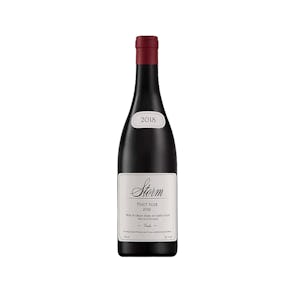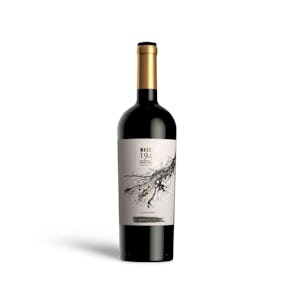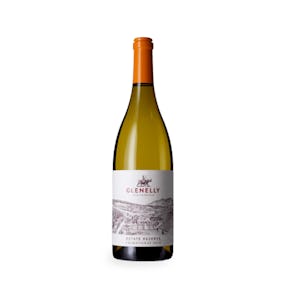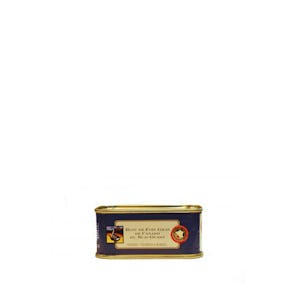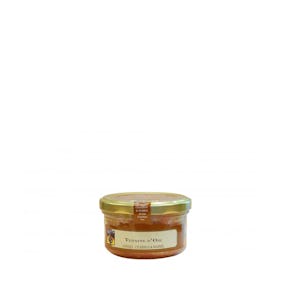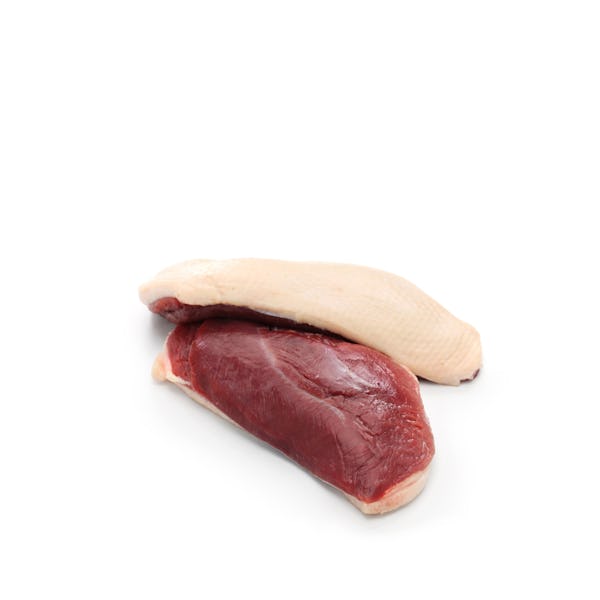
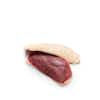
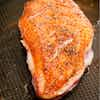
Duck Breast from France (Magret)
Beautifully plump
(Tuesday Jan 06 , 2026)
TASTING NOTES FROM THE CURATOR
Our french ducks are always of high quality, and these duck breasts are no different. It comes to you with skin on, bones off, and inner fillet removed, ready to cook.
It’s taken from the Moulard duck, a crossbreed of the Peking duck and the Muscovy duck. This duck is known for its fatty, plump, and hefty constitution. It’s very meaty, and very juicy, with a creamy and tender texture.
PREPARATION AND PAIRINGS
There are so many ways to cook and prepare duck breast. Here’s a relatively easy one, that’s sure to be a hit at the dining table:
- Thaw your duck breasts, and pat them dry with a paper towel.
- With a sharp knife, score the duck skin. Make sure you only slice the skin, and not the flesh. Season the duck breasts with salt and pepper on both sides.
- In a pot of boiling water on high heat, cook some ratte grenaille potatoes for 15-20 minutes, until a fork poked into the potatoes slides in easily. Drain the potatoes in a colander.
- On a smooth and clean surface, use the bottom of a ramekin or a glass to gently smash the potatoes. Set aside.
- Sear your duck breasts. Make sure you use a cold and dry skillet, and only turn on the heat once the duck breasts are in. Start with skin-side down. Cook for 12-15 minutes.\
- Flip the duck breasts over, and sear the other side. Note: the moment you flip it, immediately sprinkle salt onto the now-exposed skin. This will make sure it stays crispy.
- Transfer your skillet into a preheated oven at 400F, and roast for 4 minutes for medium rare, and 6 minutes for medium. Let rest on a cutting board, skin-side up for 10 minutes.
- Combine red wine, chicken stock, orange juice, and honey in a small pot, and reduce by half over medium heat. This will be your sauce.
- On the same skillet used to sear your duck breasts, fry your smashed potatoes with the remaining duck fat, until golden brown. Season with salt, pepper, and rosemary.
- Serve by slicing the duck breast into nice even slices, and drizzling your sauce over it. Serve with the smashed potatoes, and a side of arugula salad.
THE JOURNEY OF THE DUCK BREAST, OR DUCK MAGRET
The story of the magret de canard, the celebrated duck breast, unfolds like a gourmet saga entwined in the fabric of French culinary tradition. Tracing its lineage offers an intriguing journey back in time.
In the era of the Romans, duck domestication took flight in Europe, driven by the rich, succulent flavors of the meat. However, the specific notion of a ‘magret’ – a breast from a duck raised for foie gras – had not yet been conceptualized.
During the Middle Ages, duck graced many a table, traditionally in the form of whole, roast duck. It was this period that also saw the advent of foie gras, a sumptuous delicacy that lingers in the culinary narrative like an enchanting tale.
As the chronicle moves into the 17th and 18th centuries, the unique cuisine of southwestern France continued to evolve, with duck continuing to reign supreme. Yet the technique of cooking the duck breast separately had not permeated the collective gastronomic consciousness.
The 20th century signaled a defining moment when André Daguin, a Michelin-starred virtuoso from Gascony, made his mark. He was the pioneer in cooking the magret as a steak, perfectly seared and beautifully pinkish in the middle, truly revolutionizing duck cookery.
In the present era, the magret de canard is recognized as a pivotal element of French cuisine. Often served with a fruit-based sauce, such as cherry or peach, the rich duck harmonizes with a sweet-tangy contrast. While there are various methods of preparation, Daguin’s innovation of treating it like a steak holds strong.
France currently holds the distinction of being Europe’s largest duck meat producer, with the bulk of this production occurring in the history-rich southwestern regions. The Moulard duck, a seamless hybrid of the Pekin and Muscovy breeds, is typically the chosen variety, its generously-sized breast ideal for the magret.
The saga of duck breast in France mirrors the dish’s flavor and fascination, underscoring the nation’s enduring love for duck and the culinary evolution of this delectable dish over the centuries. It’s not just a meal, it’s a historic journey served on a plate, a testament to the magic of French cuisine.
Storage Instructions
Your cut of duck comes frozen and vacuum packed. Store in freezer. Thaw only when about to cook. Cooked leftover meat can only be kept in the fridge for 3 to 4 more days. Consume immediately.

